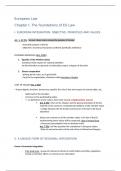European Law
Chapter I. The foundations of EU Law
I. EUROPEAN INTEGRATION: OBJECTIVE, PRINCIPLES AND VALUES
Art. 1, §2 TEU: ‘an ever closer union among the peoples of Europe’
= Essential purpose of the EU
! Objective: reconstruct European continent (politically ambitious)
FOUNDING PRINCIPLES (Art. 4 TEU)
1. Equality of the Member States
(combined with respect for national identities:
no discrimination on grounds of nationality, respect a degree of diversity)
2. Sincere cooperation
! playing by the rules, act in good faith
= loyal to the organisation, therefore called principle of loyalty
A SET OF VALUES (Art. 2 TEU)
= human dignity, freedom, democracy, equality, the rule of law and respect for human rights, etc.
- Addressed to the founders
- Common to the participating states
- >< no definitions to the values: there exist several complementary sources
Art. 6 TEU: refers to the chapter and the general principles of the EU,
inspired on the common constitutional traditions of the member states
= bridge between the EU treaties and sources of EU law to be found
elsewhere
Values are common to all the member states + the law of the EU
implementing these values will be respected: idea of mutual trust
= Necessary presumption (not an absolute truth)
Art. 7 TEU: call into question the compliance in European states
! Risks of serious breaches of the rule of law in Poland and Hungary
II. A UNIQUE FORM OF REGIONAL INTEGRATION
Forms of economic integration:
- Free trade area = group of customs territories in which duties and other regulations
having a restrictive effect on commerce are eliminated
, (border controls + taxations on the moving goods within EU are allowed)
- Customs union (douane unie) = external dimension of free trade area (free trade inside +
common approach to customs) => the substitution of a single customs territory for two
or more customs territories => same duties
= looking at relationship between EU states and the world
- Common market = within free trade area free movement beyond goods and services:
persons and capital
- Internal market = an area without internal frontiers in which the free movement of
goods, persons, services and capital is ensured
EU = a broader political project:
- Every member of national state: fundamental status of EU citizen
=> legal citizen => number of political rights
- Common economic and monetary policy
Art. 3 TEU
- An area of freedom, security and justice
- A common foreign and security policy
Regional organizations:
EU: 26 member states, no vacuum:
- EFTA: Iceland, Liechtenstein, Norway & Switzerland
= European free trade organization
Not EU States
Exchange goods + services + workers between them
Very advanced form of economic integration
- European Economic Area (‘EEA’): 3 EFTA States [not SWI] + EU
o Bound to the EU, rules that apply to them are less ambitious yet they are very
close partners to the EU
o Attached to internal EU market
Yet closer relationship EU – Norway (important producer of energy)
See also: EU – SWI (middle of Europe, important part)
& EU – UK (not part of EFTA or EEA, complexed relationship: ambitious
form of integration) & EU – Turkey (complicated, yet free movement of
goods + workers)
,Tools:
1. ‘intergovernmental’ method
= reflects the interests of each individual State => consensus + unanimity
2. ‘supranational’ method/‘community’ method
makes space for the representation of other interests, such as that of the citizens of the state
parties, as well as for the idea of a ‘common good’ going beyond the mere addition of the
interests of each individual state party => common interest of the EU
rules adopted by EU order: no need to transform / translate rules
= automatically applicable in national state
EU Law has primary and direct effect
3. ‘integration through law’
e. g. the centrality of the Treaties on the European Union,
in the process of European integration
= creating laws together has been central to the construction of EU
III. EVOLUTION
1. Towards EEC
1946: Churchill calling for a kind of United States of Europe (Zurich)
, Aftermaths of WWII: several initiatives to stimulate cooperation among European states
Council of Europe (1949), signing the European Convention for the Protection of Human
Rights and Fundamental Freedoms (ECHR, 1950) and setting up the European Court of
Human Rights (ECtHR)
1950: The Schuman Declaration (Paris)
1951: Treaty establishing the European Coal and Steel Community: ECSC (Paris)
Creating counterweights within participating states, common market
Collaborating on the production of Coal & Steek (vital materials for developed nations)
High authority that slowly will become the EU Commission
2. EEC
- created by ‘Treaty establishing the European Economic Community’
- Signature : Treaty of Rome, 1957, 6 MS
- ! treaty = subject to several amendments
- => a common market
INTEGRATION = treaty reforms (political objectives, material scope of action, tools)
+ enlargements (accession of new Member States)
Euratom: a community for atomic energy (Rome, 1957)
A SINGLE INSTITUTIONAL FRAMEWORK FOR THREE COMMUNITIES => GREATER UNITY
3. FROM EEC TO THE EUROPEAN COMMUNITY (EC) WITHIN EUROPEAN UNION (EU)
1965: Bumpy start, ‘empty chair crisis’: France refused to attend meetings -> blocked decision making
1966 SOLUTION: Luxembourg compromise: very important interests of one or more
partners at stake => negotiations have to continue until a universally acceptable
compromise is reached
1970s: strengthening the initial design
- system of own resources
(independent from financial contributions by M.S., share of VAT)
- Assembly (soon ‘Parliament’) elected by direct universal suffrage: 1979
- meetings of the ‘European Council’
(giving political guidance to ministers)
- ‘growing size’ of the institutions: to match enlargement of the EU -> further institutional reform
- Court of Justice’s key cases
(EU Law has primacy and direct effect)




